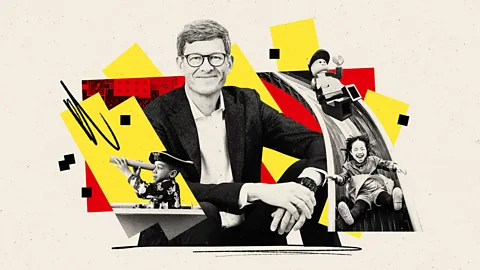Lego's CEO on the business case for play
 BBC/ Klawe Rzeczy
BBC/ Klawe RzeczyAs digital innovation reshapes the toy market, the BBC's Executive Lounge meets with Lego's Chief Executive, Niels B Christiansen, to discuss why playing around is good for children, adults and business.
Inside Lego's factory in Billund, Denmark, rows of moulding machines churn out tiny plastic pieces as robots shuttle around the shop floor. There are cupped hands, pairs of green legs, small black wheels and colourful flower petals. In all, thousands of different shape and colour combinations, that designers repurpose in new and inventive ways to make the latest play sets. Tens of billions of these bricks and bobs will be produced this year.
The name 'LEGO' is an abbreviation of the Danish words leg godt meaning "play well" and at its heart is the iconic brick, a basic interlocking building block which remains practically unchanged since it was first patented in 1958. Today the company says it produces more than 15,900 different types of bricks.
After bumper sales during the Covid-19 pandemic, the $109bn (£84bn) global toy market is facing new headwinds, such as competition with video games, squeezed consumer spending, and falling birth rates worldwide.
Niels B Christiansen ed Lego as CEO in 2017, of what was already the world's largest toymaker, and has continued the firm's ascent, out-selling Japanese video game conglomerate Bandai Namco, and major American toy and entertainment corporations Hasbro and Mattel. Even as the global toy market stalled last year, Lego bucked the trend, growing its revenue to almost $8bn (£6bn). He's been steering the firm's digital expansion, while maintaining its strength in physical play.
The toymaker's highest reach, is in the US and European markets, but the firm has pushed into China, where it now has over 500 stores, as well as the Middle East and Asia Pacific. Now it's also set its sights on India. "It's where we're not that well known, but hopefully 10 or 20 years from now, that's very different," says Christiansen.
But as it expands, Lego also faces an ever-growing challenge – what to do about its environmental impact. Research by environmental scientists at the University of Plymouth in the UK, for example, estimates that Lego blocks can take between 100-1,300 years to break down in the ocean. Plastic Lego pieces lost at sea from a cargo ship in 1997 also continue to wash up on beaches in the UK more than two decades later.
"It's something that is important for our consumers," says Christiansen. "I get a lot of letters from kids asking, 'What can you do? Can you make the bricks out of something that is more sustainable">window._taboola = window._taboola || []; _taboola.push({ mode: 'alternating-thumbnails-a', container: 'taboola-below-article', placement: 'Below Article', target_type: 'mix' });
